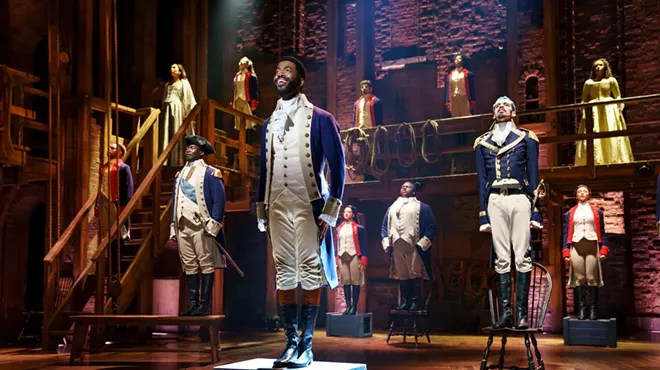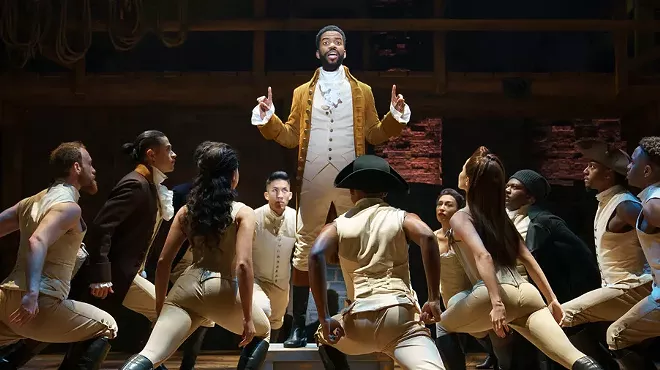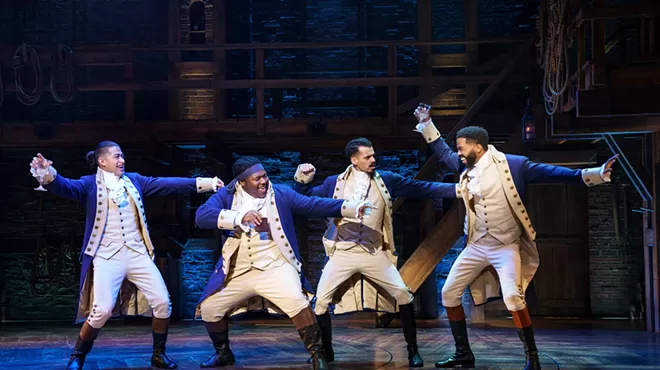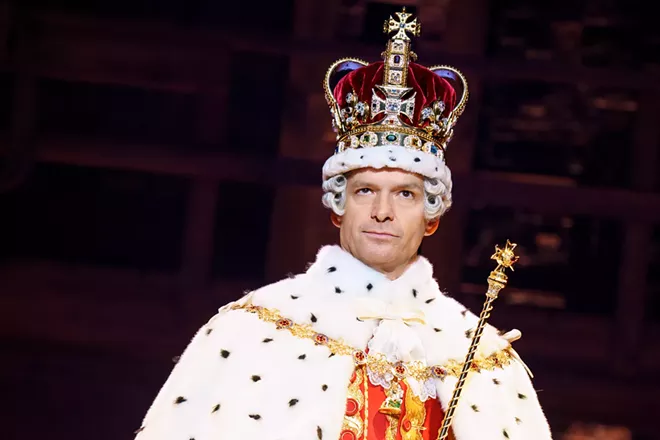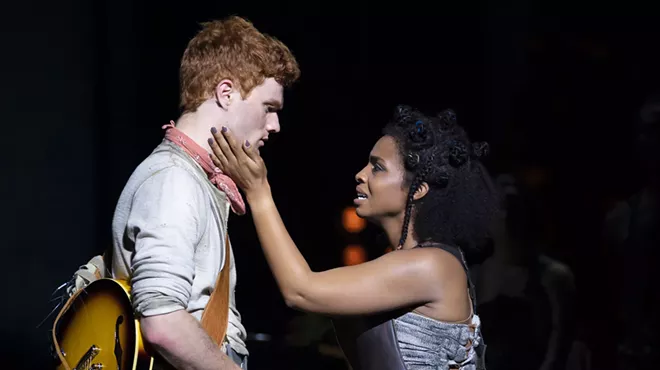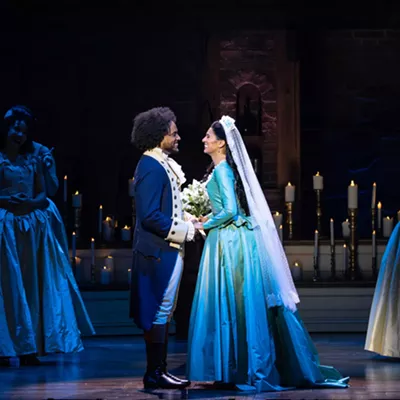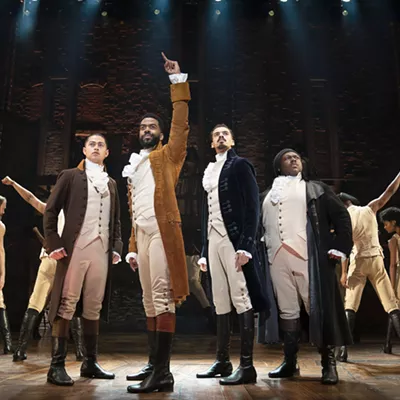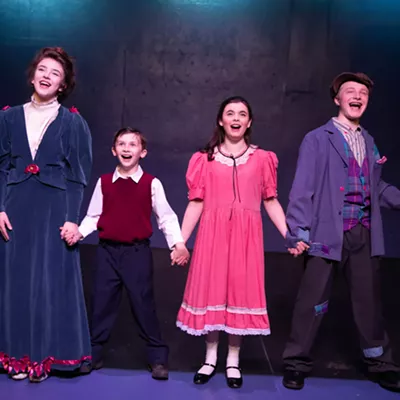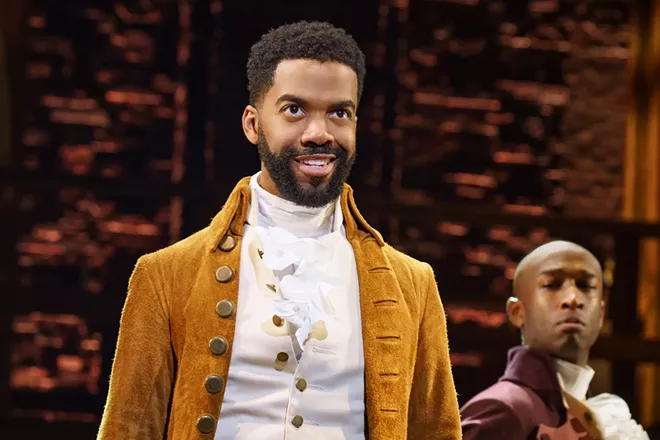
JULIUS THOMAS AS
ALEXANDER HAMILTON
"To be honest, I'm not a huge history buff," says Julius Thomas. When he was tapped to take center stage as Alexander Hamilton, he drew largely on the courses he'd taken in high school and college for character context.
"I found that in this show, everything I really needed was on the page. They did such a good job of fleshing out these characters and giving us all the information that we needed to embody these characters. It was all there, so it didn't require a ton of historical research."
Well, except for one thing. Thomas felt compelled to find out what Hamilton's signature looked like. He then practiced writing it himself.
"I sign a lot of things in the show," he says, chuckling. "There are lots of little moments where I'm giving my John Hancock — marriage papers, things of that nature — and I just wanted to have that extra layer. It's not something that anyone would ever know or see, but it helped me deepen my connection to the work we were doing."
While Hamilton could be seen as an homage to its title character, Thomas says that he's discovered a lot of self-doubt bubbling beneath Alexander Hamilton's impetuous, self-assured exterior.
"I think a lot of his actions stem from a lack of confidence, sort of a need to prove to himself and other people that he is knowledgeable and capable and a top dog. And so a lot of his actions are driven by insecurity. Which is a fun thing to play."
And for all those who, like Thomas, don't identify as history buffs? What does Hamilton hold for them?
"This is a cultural phenomenon that, at this point, millions upon millions of people have seen," he says. "It has literally changed the face of theater — how we do theater, who sees theater, how we consume theater. It really is a watershed moment, a changing of the guard to a new style. If nothing else than to witness a shift in our culture, I think it's worth seeing."
FAVORITE SONG: "Satisfied" (Angelica and Company, Act I)
THE HISTORY BOOKS SAY... It's no wonder that Lin-Manuel Miranda was so inspired by the biography of Alexander Hamilton (1755/1757–1804). The future Founding Father was born out of wedlock in the Caribbean and later orphaned, only arriving to make his way in the growing city of New York when he was a teenager. Even as a young student, though, he showed a keen insight into colonial politics and a gift for oratory. As an adult, in addition to showing skill as a military commander during the Revolutionary War, he was instrumental in establishing the United States Coast Guard, the Federalist Party and, while he was leading the Treasury Department in George Washington's Cabinet, a minor institution known as the American financial system. He married Elizabeth Schuyler in his early twenties and died in his late forties, killed in a duel by Aaron Burr.

DONALD WEBBER AS
AARON BURR
Before he played Alexander Hamilton's archrival and eventual assassin, Donald Webber's most vivid memory of Aaron Burr came from a "Got Milk?" commercial during the 1990s. In the popular TV spot — directed, incidentally, by Michael Bay of Transformers fame — a Hamilton aficionado gets a random call from a game show asking him to name the Founding Father's killer. Unfortunately, the unwitting contestant has just bitten into a peanut butter sandwich and can't get the answer out in time.
"I thought it was hilarious and brilliant, and it made me want to learn more about the most famous duel in American history," Webber writes in an e-mail.
But there's more complexity and depth to Burr than that fateful event. Webber says Burr's ambitions and motivations are made clearer through Hamilton, and they're not always so different from Hamilton himself.
"Just as Hamilton does, his need to protect the one thing his parents left him — a 'legacy to protect' — makes him act in ways that he may not have otherwise. And perhaps it would have changed the course of our history had he not felt it was a life or death matter to try to protect it."
And for Webber, the chance to share that universal story of "love, jealousy, triumph and disappointment" with a live audience is a career highlight.
"There is something unexplainable that happens when those lights dim and we tell our story," he says. "I feel the room come alive each time, and each time I step on that stage after the iconic opening notes, I too feel alive."
FAVORITE SONG: "That Would Be Enough" (Eliza and Hamilton, Act I)
THE HISTORY BOOKS SAY... Most (in)famous for being the man who shot Alexander Hamilton, Aaron Burr Jr. (1756–1836) had an interesting and accomplished life that's been overshadowed by the outcome of that tragic duel. At the age of 13, he entered Princeton University, where he showed an aptitude for literature, politics, debate and theology. Those interests would serve him well in his later career as a lawyer and a politician — a career that would also result in ideological clashes with Hamilton. During the Revolutionary War, Burr served in commanding roles in the Continental Army, and he went on to become the vice president of the United States under Thomas Jefferson. But the duel, which took place while he was still VP, left him to live out the remainder of his years in disgrace.
VICTORIA ANN SCOVENS AS
ELIZA SCHUYLER
As proof of the idea that artistic license can be more revealing than unvarnished truth, Victoria Ann Scovens developed new insight into her character by reading the novel My Dear Hamilton. She found that Stephanie Dray and Laura Kamoie's historical fiction drew a rich, biographically based portrait of Eliza Schuyler, the woman who would become Alexander Hamilton's wife.
"One of the first lines in the book is basically how Eliza was a fully formed human before she met Hamilton," Scovens writes via e-mail. "It talks about how her grandfather was a doctor, and she would go with him out into the battlefields in New York, helping to nurse injured soldiers on both sides. And she was a little bit of a tomboy. All of this helped me create a grounded human."
The rest of the detail, she says, comes from Hamilton's unusually intricate score.
"At face value, in an extreme way, Eliza could be considered an ingénue if we're talking about archetypes in a show. But what makes her more than that is how she handles the events in situations that she experiences. She is very much an active participant in her life and in Hamilton's life," she says.
Even when they endure loss, like the death of their oldest son, Philip, or a fundamental breach of trust, such as when Alexander admits his extramarital affair, Eliza doesn't let it undermine her commitment or her dignity.
"As sweet as Eliza is, she's also a no-BS kind of woman. Being soft and strong are two kind of funny traits to have. They do seem like opposites. But softness does not equal weakness, and that is something very important to understand. It's a cool role to step into every night."
FAVORITE SONG: "Satisfied" (Angelica and Company, Act I)
THE HISTORY BOOKS SAY... Elizabeth "Eliza" Hamilton (née Schuyler; 1757–1854) was born into a large, wealthy and well-connected family in New York State, which provided her with a comfortable childhood and a devout religious upbringing. It also meant that she moved in the same circles that would ultimately introduce her to her future husband while he was serving as one of Gen. George Washington's aides-de-camp during the Revolutionary War. She and Alexander endured their share of ups and downs, not least because of his affair with Maria Reynolds. After he died, Eliza founded and led the Orphan Asylum Society. She lived to the age of 97, engaged in philanthropic work and curating Alexander's legacy.
MARJA HARMON AS
ANGELICA SCHUYLER
Like many audience members, Marja Harmon "didn't know much about any of the Schuyler sisters" before she saw Hamilton for the first time. Although they were devoted wives, companions and peers of these famous historical figures, their stories hadn't crossed over into popular imagination.
Hamilton gave actors like Harmon the opportunity to bring those stories into the spotlight — with a little help from poignant, showstopping songs like "Satisfied."
Angelica Schuyler, Harmon writes via e-mail, "was ahead of her time and didn't let her gender stop her from being highly influential. She used her charm and status to gain access to the great minds of that time. Alexander Hamilton, Thomas Jefferson and Ben Franklin corresponded with her regularly and sought her counsel."
Nevertheless, Angelica wasn't just an intelligent, influential socialite who dazzled the political movers and shakers of the day. She was human, and she struggled with the same doubts and longings that many of us do. A significant narrative thread in Hamilton is Angelica's relationship with Alexander Hamilton and the conflict she may have experienced in her sister marrying the man who may well have been her soulmate.
"I really enjoy playing with her choice of duty versus desire," Harmon says. "Her loyalty and commitment to seeing her sister's happiness stops her from seeking her own. She makes incredible sacrifices for her family, but throughout the show deals with the constant 'what if?' So much of her journey in the show is so bittersweet."
FAVORITE SONG: "Wait For It" (Burr and Company, Act I)
THE HISTORY BOOKS SAY... Angelica Church (née Schuyler; 1756–1814) was the older sister of Eliza and therefore benefited from a privileged childhood in the same wealthy landowning family. Angelica likewise moved in elite political and social circles, although she spent a decade and a half living abroad with her husband, John Barker Church, a British-born merchant who supplied the American and French armies and later became a member of the British Parliament. She developed friendships and corresponded regularly with some of the most prominent figures of the day, including George Washington and Thomas Jefferson. While it's well known that she charmed and deeply connected with Alexander Hamilton, it's less clear whether their relationship became romantic.
RICK NEGRON AS
KING GEORGE III
Every now and again in Hamilton, Rick Negron pops up as King George III to weigh in on the American political strife through a catchy series of songs like "You'll Be Back" and "What Comes Next?"
"The trap with this character is to play him as a clown or fool, a broad caricature of our assumptions," Negron writes via e-mail.
"The real trick is to play him as close to the vest as possible, letting his idiosyncrasies bubble up whenever he is triggered. Our director, Thomas Kail, always reminded me that the king only must gesture minutely to dispense with an enemy. Less is always more with George III."
To research his role beyond the few facts he remembered from high school, Negron began with Lin-Manuel Miranda's starting point: Ron Chernow's biography Alexander Hamilton. Then he read The Last King of America by Andrew Roberts and George III by Christopher Hibbert. He also watched BBC documentaries on the king and his era. It gave him a new appreciation for the monarch who was mocked and later extolled as "Farmer George."
"George was intelligent and very involved in politics. He was loyal to his wife and very frugal. He loved books, music, science and agriculture," Negron says, and playing him in Hamilton is a "dream role" because "it's probably one of the greatest pieces of musical theater in the last 50 years."
FAVORITE SONG: "Dear Theodosia" (Burr and Hamilton, Act I)
THE HISTORY BOOKS SAY... George William Frederick (1738–1820) ruled as King George III of Great Britain between 1760 and 1820. His six-decade reign was characterized by a series of major military conflicts, including the Seven Years' War (1756–1763) and the Napoleonic Wars (1803–1815) with France, as well as, of course, the American War of Independence (1775–1783). Although George gets a bad rap as an effete, tyrannical and out-of-touch leader — charges that are certainly warranted in some cases, especially when it comes to his early support of the transatlantic slave trade — he championed major scientific and agricultural advances in Britain and maintained an honest self-appraisal of his own strengths and failings. ♦

